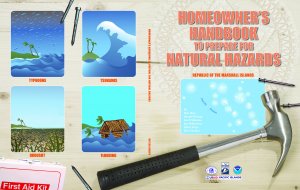Introduction
When a natural hazard occurs – whether it be a tropical cyclone, tsunami, extratropical storm, king tide, flood, sea-level rise, erosion, or drought – the results can be devastating for your land, your home, your family, and your possessions. Financial losses can be particularly high in the two administrative centers of the northern and southern Marshall Islands – Majuro and Ebeye, Kwajalein – which have seen explosive growth in both population and land area since the mid-1940s. This has been especially true in Majuro, where a number of lagoonal openings along Majuro Atoll were connected by the US Navy to form the single 30 mile strip of land that today is home to over half of the Marshall Islands population. Adding to the island’s horizontal growth, seawalls have become a common feature on Majuro covering over 30 percent of eastern Majuro’s shoreline. As a result, the area comprising Delap-Uliga-Djarrit and the Amata Kabua International Airport built in 1967 – has grown by 170 acres or about 40 percent due to engineering. With this aggregation of people and development in Ebeye, Kwajalein, and eastern Majuro especially, Marshall Islanders and their homes have become increasingly exposed to potentially dangerous natural hazards.
This handbook was created to help you prepare for a natural hazard so that risks to the family and property may be reduced. While it is never possible to eliminate all damage from a natural hazard, you as a homeowner can take action and implement many small and cost-effective steps that could significantly lower your risk. Mother Nature can be intense. Your family deserves the protection that only you can provide.


